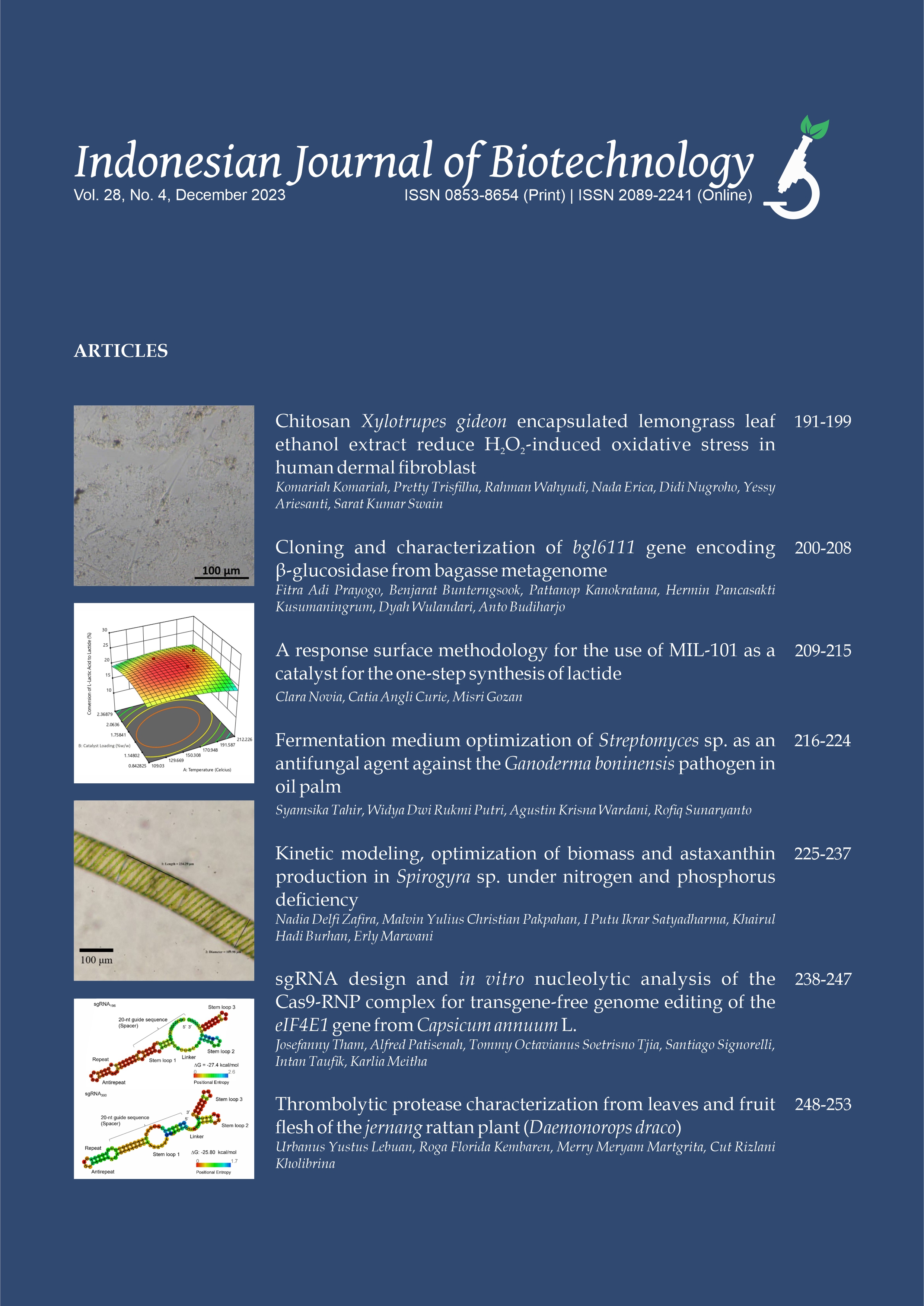Biochemical properties of crude extracellular proteases from Chromohalobacter salexigens BKL5 and Micrococcus luteus 11A
Ayu Ashari Achmad(1), M. Saifur Rohman(2*), Irfan D. Prijambada(3)
(1) Laboratory of Agricultural Microbiology, Department of Agricultural Microbiology, Faculty of Agriculture, Universitas Gadjah Mada, Yogyakarta 55281, Indonesia
(2) Laboratory of Agricultural Microbiology, Department of Agricultural Microbiology, Faculty of Agriculture, Universitas Gadjah Mada, Yogyakarta 55281, Indonesia
(3) Laboratory of Agricultural Microbiology, Department of Agricultural Microbiology, Faculty of Agriculture, Universitas Gadjah Mada, Yogyakarta 55281, Indonesia
(*) Corresponding Author
Abstract
In this work, we have reported an enzymatic activity and biochemical properties of extracellular proteases from Chromohalobacter salexigens BKL5 and Micrococcus luteus 11A. C. salexigens BKL5 and M. luteus 11A were previously isolated from Bledug Kuwu mud volcano and dietary industry wastewater treatment, respectively. Both bacterial strains were able to produce extracellular proteases, when grown on minimal agar medium supplemented with 1% of skim milk. Proteolytic indexes of C. salexigens BKL5 and M. luteus 11A were 2.5±0.14 and 2.9±0.42, respectively. Both extracellular proteases exhibited optimum enzymatic activity at pH 7, with specific activity of C. salexigens BKL5 was 13.3% higher than that of M. luteus 11A. Optimum temperature for enzymatic activity of both proteases was 45°C. Metal cofactor preferences assay showed that extracellular protease from C. salexigens BKL5 preferred Zn2+, meanwhile extracellular protease from M. luteus 11A mainly preferred Ca2+ ion. Metal cofactor preferences assay also suggested that crude extracellular protease from C. salexigens BKL5 was categorized as metalloprotease, meanwhile crude extracellular protease of M. luteus 11A was common neutral protease. The enzymatic stability assay against various salt concentrations showed that crude extracellular protease from C. salexigens BKL5 was more stable than that of M. luteus 11A.
Keywords
Full Text:
PDFReferences
Aghajari, N., Petegem, F. P., Villeret, V., Chessa, J. P., Gerday, C., Haser, R. and Beeumen, J.V. 2003. Crystal structures of a psychrophilic metalloprotease reveal new insights into catalysis by cold-adapted proteases. Prot. 50:636–647.
Cudic, M and Fields, G.B. 2009. Extracellular proteases as targets for drug development. Curr. Protein Pept. Sci. 10(4):297–307.
Culp, E. and Wright, G.D. 2017. Bacterial proteases, untapped antimicrobial drug targets. J. Antibiot. 70, 366–377.
Drag, M. and Salvesen, G.S. 2010. Emerging principles in protease-based drug discovery. Nat. Rev. Drug Discov. (9):690–701.
Feder, J, Garrett, L.R., and Wildi, B.S. 1971. Studies on the role of calcium in thermolysin. Biochem. 10(24):4552–4556.
Hartley, B.S. 1960. Proteolytic enzymes. Annu. Rev. Biochem. 29:45–72.
Hedstrom, L. 2002. Serine protease mechanism and specificity. Chem. Rev., 102:4501–4523.
Hirokoshi, K. 1971. Production of alkaline enzymes by alkalophilic microorganism. Part I. Alkaline proteases by Bacillus No. 221. Agric. Biol. Chem. 9:1407–1414.
Jiang, W and Bond, J.S. 1992. Families of metalloendopeptidases and their relationships. FEBS Lett. 321(2,3):110–114.
Kunitz, M. 1946. A spectrophotometric method for the measurement of ribonuclease activity. J. Biol. Chem. 164:563–568.
Lopez-Otin, C. and Overall, C.M. 2002. Protease degradomics: a new challenge for proteomics. Nat. Rev. 3:509–519.
Nishio, Y., Nakamura, Y., Kawarabayasi, Y., Usuda, Y., Kimura, E., Sugimoto, S., Matsui, K., Yamagishi, A., Kikuchi, H., Ikeo, K. and Gojobori, K. 2003. Comparative complete genome sequence analysis of the amino acid replacements responsible for the thermostability of Corynebacterium efficiens. Gen. Res. 13:1572–1579.
Polgár, L. 2005. The catalytic triad of serine peptidases. Cell. Mol. Life Sci. 62:2161–2172.
Prajapati RS, Das M, Sreeramulu S, Sirajuddin M, Srinivasan S, Krishnamurthy V, Ranjani R, Ramakrishnan C, Varadarajan R. 2007. Thermodynamic effects of proline introduction on protein stability. Prot. 66(2):480–91.
Puente, X.S, Sanchez, L.M, Gutierrez-Fernandez, A., Velasco, G., Lopez-Otin, C. 2005. A genomic view of the complexity of mammalian proteolytic systems. Biochem. Soc. Trans. 33:331–334.
Rao, M.B., Tanksale, A.M., Ghatge, M.S., and Deshpande. V.V. 1998. Molecular and Biotechnological Aspects of Microbial Proteases. Microbiol. Mol. Biol. Rev. 62(3):597–635.
Ravaud, S., Gouet, P., Haser, R. and Aghajari, N. 2003. Probing the role of divalent metal ions in a bacterial psychrophilic metalloprotease: Binding studies of an enzyme in the crystalline state by X-ray crystallography. J. Bacteriol. 185(14):4195–4203.
Rawlings, N.D., Barrett, A.J. and Finn, R.D. 2016. Twenty years of the MEROPS database of proteolytic enzymes, their substrates and inhibitors. Nucleic Acids Res. 44:D343–D350.
Rohman, M.S., Prijambada, I.D., Indriyani, Y.A., and Hendrosatriyo, H., 2012. Identification of protease producing halophilic bacteria from Bledug Kuwu mud volcano. IJ. Biotech. 17(1):35–41.Rohman, M.S. Pamulatsih, E., Kusnadi, Y., Yuwono, T., and Martani, E. 2015. An active of extracellular cellulose degarding enzyme from termite bacterial endosimbiont. IJ. Biotech. 20(1):62–68.
Sauer, R.T., Bolon, D.N., Burton, B.M., Burton, R.E., Flynn, J.M., Grant, R.A., Hersch, G.L., Joshi, S.A., Kenniston, J.A., Levchenko, I., Neher, S.B., Oakes, E.S., Siddiqui, S.M., Wah, D.A., and Baker, T.A. 2004. Sculpting the proteome with AAA+ proteases and disassembly Machines. Cell 119, 9–18.
Tajima, M., Urabe, I., Yutani, K., and Okada, H. 1976. Role of Calcium ions in the thermostability of thermolysin and Bacillus subtilis var.amylosacchariticus neutral Protease. Eur. J. Biochem. 64:243–247.
Tripathi, L.P and Sowdhamini, R. 2008. Genome-wide survey of prokaryotic serine proteases: Analysis of distribution and domain architectures of five serine protease families in prokaryotes. BMC Genomics, 9(549):1–28.
Tsuru, D., Kira, H., Yamamoto, T., and Fukumoto, J. 1966. Studies on bacterial protease: Part XIV. Zinc as an essential metal component of neutral protease of Bacillus subtilis var. amylosacchariticus. Agric. Biol. Chem. 80(9):856–862.
Uehara, H., Yoneda, Y., Yamane, K. And Maruo, B. 1974. Regulation of neutral protease productivity in Bacillus subtilis: Transformation of high protease productivity. J Bacteriol. 119(1): 82–91.
Article Metrics
Refbacks
- There are currently no refbacks.
Copyright (c) 2016 The Author(s)

This work is licensed under a Creative Commons Attribution-ShareAlike 4.0 International License.









